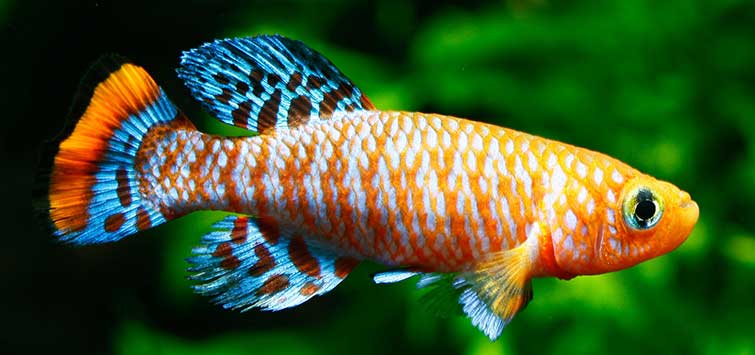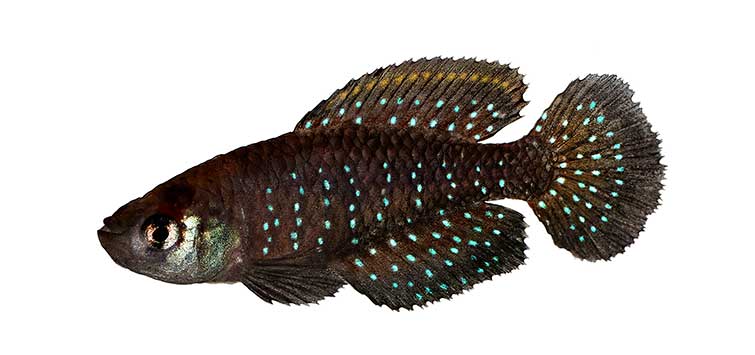Annual Killifish: A Story of Survival
Author: Charles Nunziata
Surviving in some of the most extreme environments for freshwater fish, annual killies have evolved fascinating behaviors in order to thrive and reproduce.
Living in some of the most demanding and dynamic environments faced by any aquatic vertebrate, annual killifish have had to develop extraordinary adaptations in order to survive. The term “annual killifish” refers to those killies that inhabit temporary bodies of water and are born, reproduce, and die within a one-year period. Among their numerous survival strategies, they exhibit extremely rapid growth, eggs that can withstand drying, and the ability to tolerate an ever-changing set of water parameters.
Living in a Tough Environment
Annual killifish are found in Africa, on the east coast and some interior countries, as well as throughout South America, from the northern limits of the continent to Argentina. All annual killifish habitats share a common characteristic: They experience one or two rather short periods of major rainfall, interspersed with long periods where little or no rain occurs. Indentations and floodplains fill during the rainy seasons, forming pools and wetlands, which slowly evaporate after the rainfall ends and remain completely dry until the next rain event.
These temporary habitats are both dynamic and unreliable. In any given year, the rainy season may start earlier or later than expected and is sometimes preceded by rain events that last a day or two. The resulting pools do not last very long and typically dry before the onset of the main rainy season, killing any aquatic life that may have arisen.
With the rains come all manner of wildlife to share the water, roiling and contaminating it. These are joined by predators, primarily birds, insects, and amphibians that pick off the colorful killifish. In addition to the obvious physical challenges they present, isolated habitats also have the potential of limiting genetic diversity. Annual killifish embryos must also be very resilient; they must survive incubation in a hot and desiccated substrate, and hatch at a time that guarantees fry survival.
Killfish Survival
When taken together, these factors should be able to overwhelm even the most creative set of survival strategies, yet annual killifish have survived for millennia. Their story of survival continues to amaze everyone, including the most well-read professionals.
The somewhat-demanding annual killies have specific maintenance and nutritional requirements that must be met in order for them to be able to breed successfully. In general, raising fish from eggs is not a terribly difficult endeavor. That is not the case with annual killifish, however: Improper storage and hatching techniques are often the reason why some people fail to breed these fish successfully. Maintaining correct water parameters and knowing when to initiate hatching are essential to raise this group of fish.
How Annual Killifish Hatch
I will arbitrarily choose the hatching event as a starting point for my discussion of annual killifish survival strategies. When the rains become continuous, the ponds and wetlands fill quickly, and most eggs will complete their developmental cycle and hatch a few days later. Annual killifish fry are able to fend for themselves upon reaching the free-swimming stage, which typically occurs a few hours after hatching.
At about the same time fry hatching begins, food sources in the form of microscopic organisms and insect larvae become available. Although the fry are relatively small, they are equipped with teeth that allow them to bite off pieces of food items that may be too large to consume whole.
The fry grow very rapidly, with some individuals being able to spawn in as little as three weeks (Watters, 2009). There are two major reasons for this: If the rains were from an occasional storm occurring outside of the rainy season, the pool may dry out quickly.
Rapid maturation allows the species to begin reproducing within weeks of hatching, assuring species survival even if the pool is short lived.
Although not well studied, the second reason is very complex and has to do with the genetics of males. In general, the dominant males, which are fast growing and colorful, breed first and also tend to die first due to predation or aging. As the dominant males are removed, some subservient males apparently increase their size rapidly and develop their adult coloration. They assume the dominant role until they are taken by predators or age, cueing the next group to develop.
Hobbyists see this effect in their fishrooms: A few males exhibit tremendous growth when compared to the rest of the fry. If those males are not removed quickly, the subservient males will never develop. This ingenious mechanism increases the number of individuals who contribute to the genetic pool, helping conserve the widest degree of genetic diversity.
Egg Development
The annual killifish embryo also faces many challenges to its survival. There are primarily two factors it must overcome: It must survive for months in a hot and desiccated environment, and it must hatch at a time when its survival is secure. The survival strategies in play here are may be even more amazing than those employed by the living fish.
Nothobranchius species deposit their eggs just below the surface of a black mud that forms the substrate of their habitat. Conversely, many deep-diving South American species take advantage of the loose and soft substrate that lines their habitat to completely bury themselves when spawning. At a certain point in the incubation process, all annual killifish embryos require access to air. Therefore, the substrate must dry and crack in a manner that allows gas exchange to extend to the areas where the eggs are (Watters, 2009).
Depending on a complex set of environmental factors, annual killifish eggs do not develop at uniform rates but reach certain stages and then cease further development. This arrested development is known as diapause, and they remain in it until environmental cues trigger them to resume. Some factors that affect the rate and progress of egg incubation are when the eggs are buried in the upper layer of the substrate upon spawning, once the surface dries and cracks, when temperature changes and gas exchange occurs, and when the rains fill the pool again.
Embryonic Development
Generally, the embryonic development is divided into three stages. Most eggs appear to be programmed to reach the third stage when the rainy season occurs at the expected time of year for their region. The majority of the embryos will hatch a few days after the pools and wetlands fill (Watters, 2009).
Most of the time, once the rainy season starts, eggs continue to hatch throughout the rainy season. However, isolated rainfalls or a false start to the rainy season can fill a habitat that then dries out, killing any fry that have hatched. There may also be rainless droughts that last more than a year, killing off any eggs that have reached the final stage of development. Clearly, if all the eggs reached the final stage simultaneously, the species would not survive an extended drought or false start to the rainy season.
Therefore, the eggs of annual killifish do not reach the final stage of development at the same time. A small percentage of embryos may remain at earlier stages of development for weeks, months, and some suspect even years. As a result, at almost any point in the life of a pond or wetland, there will be embryos at different stages of development and some eggs will always be ready to hatch whenever the rains actually occur, be it months or years out of the normal sequence.
In a last twist, some annual killifish do not need to go through all three stages of diapause. The stages that are not essential are dependent on a variety of environmental factors: temperature, oxygen levels, CO2, and residual moisture (Leibel, 1982; Watters, 2009). Being dependent on a complex set of variables is yet another mechanism guaranteeing that there will always be some eggs ready to hatch whenever the rains actually come, thereby providing for the survival of future generations.
Keeping Killies
Over the years, members of the American Killifish Association (AKA) and others have used the knowledge of annual killifish survival strategies to come up with ways to keep and breed them in an aquarium.
There may be no bigger thrill in the hobby than to observe the heart of the killifish embryo as it pumps blood through its still-developing body. Nor will anyone forget the first time they watched dozens of fry, so small, yet completely ready to thrive, as they hatch from a dry lump of peat moss. Seductive and awe inspiring, these sights both inspire and humble, and to me are an affirmation of life. Participating in life at this level has a special quality, I think—one that motivates so many of us who have spent the better part of our adult life in the presence of fishes.
Sources
Leibel, Wayne S. 1982. “Review of recent observations on the phenomenon of annual egg diapause.” Journal of the American Killifish Association 15(3):83–100.
Watters, Brian. 2009. “The Ecology and Distribution of Nothobranchius Fishes.” Journal of the American Killifish Association 42(2).
How to Breed Annual Killifish
Understanding annual killifish survival strategies provides the hobbyist with insights about how to effectively breed the fish as well. A properly matched pair of healthy adult annual killifish will almost always spawn. They produce hundreds of eggs if preconditioned properly and provided an appropriate substrate. However, success depends on proper egg incubation.
Step 1: Isolate Fast-Developing Males
The fastest-developing males are the shortest lived. Remove these from the clutch in order not to select for short lived males, and select for color and shape from the next group of emerging males. Select one to three females with slightly rounded, not sunken abdomens. Isolate the male, and prepare the breeders for spawning with live and frozen foods.
Step 2: Soak Some Moss
Use fertilizer-free, horticultural-grade sphagnum peat moss, soaked or boiled to promote sinking. Add to a drum bowl filled with aged water to the depth recommended for the species. Leave breeders for at least 10 hours, but not more than 24; do not feed. The group can be spawned again after a week’s rest and reconditioning.
Step 3: Pour Out the Water-Peat Mix
Remove the fish, pour the water-peat mix through a fine net, and squeeze until little water remains. Place between layers of newspaper for 24 hours, and then store the slightly damp peat in a poly bag tied or folded to prevent air exposure, but do not heat seal.
Step 4: Incubate
Test hatch after incubating at room temperature for the period recommended for the species: Put 25 percent of the peat in a clear container, add aged water, and examine periodically for fry. If developed, most fry will hatch in two days. If not, re-dry the peat and store for another month. Repeat this process until a successful hatch occurs, then wet the balance of the peat. After hatching is complete, re-dry the peat for another month or two. This allows eggs still in the first two stages of diapause to complete their development. A second incubation commonly results in additional fry.
Step 5: Change the Water Three Times per Week
Most fry take small live foods immediately. Smaller species may require microscopic foods for the first few days, easily provided by adding well-seasoned plant matter. Growth is rapid. Keep rearing tanks clean by conducting water changes three times per week, and to prevent stunting, double or quadruple water volume at least every week during the first month. Maintenance thereafter is straightforward. Males start coloring up at three weeks, and viable eggs are produced in six to ten weeks.
A successful spawn and hatch of an annual killifish is an experience unlike any other in the hobby.

.png?h=595&iar=0&w=2781&hash=5FD5E69473BCC22199FBFA2FB71B6033)



